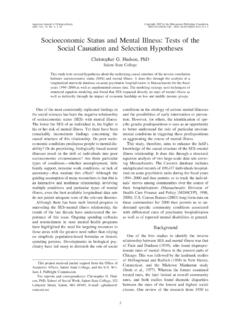Transcription of LABOUR ECONOMICS I ECO 213 COURSE OUTLINE AND …
1 LABOUR ECONOMICS I ECO 213 COURSE OUTLINE AND LECTURE NOTES 1. Meaning/definition and scope of LABOUR ECONOMICS - LABOUR ECONOMICS in perspective - LABOUR Market and the economy 2. Nature of LABOUR problems in developing economies - The problem of child LABOUR - Causes of child LABOUR - Ways of tackling the problem of child LABOUR 3. LABOUR force - Definition and factors influencing the size and composition of LABOUR force. - Worker mobility and turn over - Sectorial distribution of LABOUR force - Population growth and its implication on LABOUR force 4. Concept of unemployment - Types of unemployment - Causes of unemployment - The nature of unemployment in Nigeria - Consequences of unemployment - Using monetary policy as a tool in solving the problem of unemployment 5.
2 LABOUR demand and LABOUR supply - Simple model of LABOUR demand - Elasticities of demand for LABOUR - Supply of LABOUR - Determinants of the supply of LABOUR - Determinants of equilibrium of wage rate 6. Informal and Formal (modern) sectors 7. LABOUR market theories - The role of the theory - Types of LABOUR market theories - Classical model of LABOUR market theory 8. LABOUR distribution - Types and factors affecting LABOUR distribution in an economy - Industrial and occupational distribution of LABOUR 9. ECONOMICS of wage determination 10. Features of Nigeria LABOUR market 11. Performance of the Nigeria LABOUR market 12. Manpower development INTRODUCTION OF LABOUR ECONOMICS : In previous lectures on ECONOMICS adequate attention has been given to the concept of economic.
3 ECONOMICS problems, scope of ECONOMICS and its branches, now, we introduce LABOUR ECONOMICS which is a subdivision of ECONOMICS . LABOUR is one of the primary factors of production other factors include. LABOUR , capital and enterpreurship derived demand, these are input we derive. Note that LABOUR is the collect name given to the productive service, embodied in human physical efforts, skill, intellectual power. There are different types of effort and skill content. This means that LABOUR input is not homogeneous according to the principle of ECONOMICS production. Resources are relatively scarce or limited this means that the desire of consumer, business and governmental unit for goods and services exceed our productive capacity.
4 Since resources are scarce and the want unlimited, society is obliged to manage this resource efficiently. LABOUR ECONOMICS therefore looks at ways LABOUR as a resource could be efficiently utilized. DEFINITION LABOUR ECONOMICS : LABOUR ECONOMICS is the branch of ECONOMICS which studies the workings and outcomes of the market for LABOUR services, LABOUR ECONOMICS deals with the behavior of employers and employees to the pecuniary (wages, prices, profits) and non-pecuniary (working conditions, work environmental) aspects of the employment relationship firms operate in three markets as they pursue their objectives of profit maximization; the LABOUR markets, the capital market and the product market. It is the study of the LABOUR force as an element in the process of production.
5 LABOUR force comprises a part of the population which is employed or available for work. The LABOUR force is made up of all those who work for gain whether as employees, employers or as self-employed. It also includes the unemployed who are seeking for employment. LABOUR ECONOMICS is therefore the study of the factors affecting efficiency of workers, their development between different industries and occupations and the determination of their pay. IMPORTANCE OF LABOUR ECONOMICS : The study of LABOUR ECONOMICS is importance for the following reasons. 1. It helps economists to understand LABOUR related problems Issues on fair wage or salaries workers, welfare of workers, LABOUR productivity, workers safety, gender related matters, job security and Job satisfaction.
6 2. The study important in providing data for economic planning and policy It helps economists to know the contribution of LABOUR services to peoples income (wages and salaries). There is evidence that in most economy, LABOUR input is the most of economic resources. 3. The study of LABOUR ECONOMICS helps us to understand the nature of the market in which LABOUR services are bought and sold. SCOPE OF LABOUR ECONOMICS LABOUR ECONOMICS is concerned with issues that affect or concern the LABOUR force. Issues that concerns LABOUR forces include; 1. LABOUR mobility and migration 2. LABOUR markets 3. Supply of LABOUR 4. Unions and collective bargaining 5. Work leisure decision 6. Government and institutions 7. Participation rates of LABOUR 8.
7 Wage structure 9. Quality of LABOUR 10. Personal distribution of earning 11. LABOUR productivity 12. Wages and inflation 13. Employment and unemployment Most of the above issues are discussed under topics in micro ECONOMICS theory and macroeconomics. IMPORTANCE OF SOME OF THE SCOPES OF LABOUR ECONOMICS : 1. mobility of LABOUR /worker mobility and Migration it refers to the ease with which LABOUR can move from one occupation or geographical area to another. It has two components or aspects namely: Geographical mobility of LABOUR : is the movement of LABOUR between geographical locations or areas. That is mobility of workers from one region, country and location to another. If the present value of the benefits associated with mobility exceeds the costs, both monetary and psychic, we assume that LABOUR will decide to change jobs or move, or both.
8 Also if the discounted stream of benefits is not as large as the costs, then people will decide not to change jobs. Occupational mobility of LABOUR it measures the extent to which workers change occupation or skills in response to differences on their wages or job availability. Migration is highly selective in the sense that it is not an activity in which all people are equally likely to be engaged. To be specific, mobility is much higher among the young and better educated than the old. Characteristics of Migrants a. Age: is the single most important factor in determining who migrates. The peak years for mobility are 20 24; 12% of this age group migrates across the country or state lines each year.
9 By age 32 the rate of migration begins to drop gradually and by age 42 it drops very low. There are two reasons for this situation. Firstly, migration is greater among the young with great potentials and ability to take high risk. They bring high investment returns from any human capital investment. Secondly, a large part of the cost of migration are psychic, the losses associated with giving up friends, community ties, and benefits of knowing ones way around can easily be forgone because at such early adult age one is not yet established as a matured adult. However as one grows older such things begin to count. b. Education: while age is the best indicator of who will move, education is the best indicator of who will move within the age group.
10 Educated people tend to want to migrate more to areas where they can find good jobs with high wages and incentives within the country or outside the country. One cost of migration is ascertaining where the opportunities exist and how lucrative are the jobs. c. The role of distance: As the cost of migration gets higher the desire for mobility reduces as a result. There is also the cost of getting relevant information of where opportunities exist. This can either encourage or discourage LABOUR from migrating. 2. LABOUR Market:- It is the market in which wages and conditions of employment are determined. Remember that in the market system the forces of demand and supply determine commodity prices while in the LABOUR market, what we talk about is service and the wages for LABOUR services.








